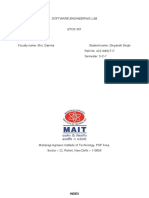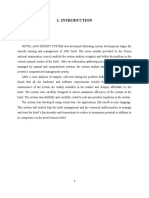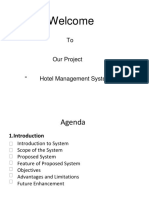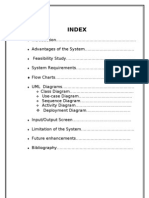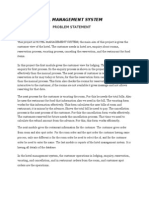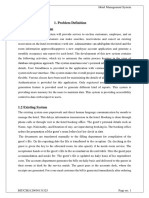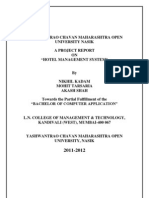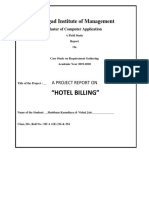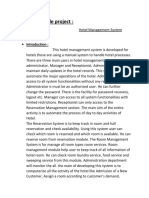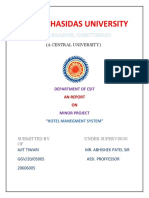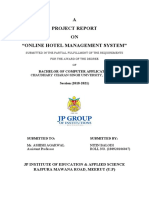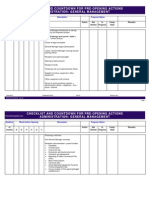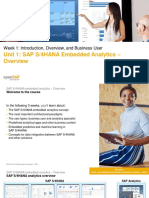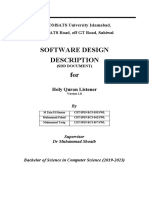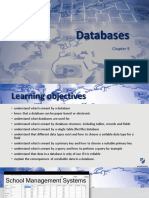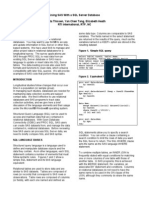PRELIMINARY
ANALYSIS
Existing System
Hotel Breeze Ritz is based in Goa and is one of the best and most
luxurious hotels in Goa. Hotel Breeze Ritz also offers round the
clock coffee shop and room service for its guests. There are 30
single rooms !" double rooms #" suites and #0 villas for its special
guests. Ritz has hired a $ell%trained staff and managers to provide
the best possible services to its guests. Ritz has al$a&s tried their
best to maintain guest information $hether the& are currentl& sta&ing
$ith them or the& have leaved through a semi computerized hotel
management s&stem. The desk manager checks in his computer if a
room suiting guest's need is empt& and then asks the guest to fill up
a small form to kno$ about their details. These details are then
entered in the hotel management s&stem. Hotel management s&stem
maintains the record of the room occupanc& and the guests currentl&
sta&ing $ith them respectivel&. (&stem also maintains the billing of
the guest according to their respective room t&pes and time of sta& at
the Ritz.
)resent s&stem is not able to maintain information about hotel staff
i.e. managers room service laundr& staff etc. *s soon as the s&stem
is intimated of guest departure the s&stem generates the total of guest
bill and then deletes all the guest information on bill clearance the
desk manager needs to cop& all the details in a separate register to
maintain a guest database of the ones $ho have sta&ed $ith Ritz.
This practice $as not found effective $hen the entries in the register
kept on increasing and later searching became a big mess. Ritz $ants
to provide reservation services but such a option is not available in
its current s&stem. The guests are asked to fill the form having
follo$ing particulars%
+ame
*ddress
)hone no.
,heck in date and time
Problems with current system
,urrent s&stem used b& Ritz is a semi%computerized s&stem in sense
that it does not maintain database of the guests $ho have checked
out of hotel. The staff needs to cop& the guest details in a register
before clearing billing details as data about the guest is deleted from
the s&stem after clearance of bills. This practice is not efficient as b&
each da& the no. of entries in the database increase and as it is not
computerized later information search takes a lot of time and the
error is expected to be high as cop&ing from the computer is not
error proof. )resent s&stem doesn't offer an& service for room
reservation $hich is must for a hotel like Ritz dealing $ith reputed
people that to in such a large no. )resent s&stem doesn't maintain
an& information of the staff i.e. record of all the staff members such
as laundr& man floor $ise room cleaning and maintenance staff.
PURPOSE (O this !ocument"
The origin of most soft$are s&stems is in the need of a client $ho
either $ants to automate the existing manual s&stem or desires a ne$
soft$are s&stem. The soft$are s&stem is itself created b& the
developer. -inall& the end user $ill use the completed s&stem. Thus
there are three ma.or parties interested in a ne$ s&stem/ the client
the user and the developer. (omeho$ the re0uirements for the
s&stem that $ill satisf& the needs of the clients and the concerns of
the users have to be communicated to the developer. The problem is
that the client usuall& the soft$are or the soft$are development
process and the developer does not understand the clients problem
and the application area. This causes a communication gap bet$een
the parties involved in the development of the pro.ect.
The basic purpose of soft$are re0uirement specification is to
bridge this communication gap. (R( is the medium through $hich
the client and the users need are accuratel& specified1 indeed (R(
forms the basis of soft$are development.
*nother important purpose of developing an (R( is helping
the clients understanding their o$n needs. *n (R( establishes the
basis for agreement bet$een the client and the supplier on $hat the
soft$are product $ill do.
*n (R( provides a reference for validation of the final product.
* high 0ualit& (R( is a prere0uisite to high 0ualit& soft$are
and it also reduces the development cost.
O#er$tions or #ro#ose! system
The ne$ s&stem should support follo$ing operations such as%
*dd guest or allot room.
This is 2 process needing the guest fill up a small form
mentioning his basic particulars and this information is later
fed in the computer.
)resent status
This operation tells the present status of the hotel in all terms
till that da& i.e. rooms and the guests sta&ing in the hotel total
bill amount.
Room search
This option asks for the room t&pe $hich needs to be checked
for a sta&. * customized search can also be performed for
guest's convenience such as floor no. and room no.
Room reservation
Room reservation option should provide a service to reserve a
room in the hotel if one is available and later could be given o
a guest if guest can manage till the reservation time $hich is
hard to maintain in a manual s&stem.
3onthl& report
(&stem should generate a monthl& report of the hotel's
business in the past month i.e. room occupanc& details t&pe of
room mostl& occupied most revenue generating room t&pe
and the total billing details.
4iscount service for the guests $ho revisit the hotel in a
month or a t$o or to the guests $ho keep on visiting Ritz
regularl&.
4atabase management s&stem
The s&stem should maintain the information of the all the
guests $ho earlier sta&ed $ith the Ritz $ith 0uick search
options in it $ith parameters like name phone no. cit& etc.
+o unauthorized access to guest database and s&stem should
be entertained1 therefore a pass$ord protection feature needs
to be present in the ne$ s&stem.
The s&stem should be directl& linked to the internet allo$ing
the guests to even check hotel's details and hence enabling
online reservation.
%EASI&ILI'Y O% '(E PRO)U*'
The feasibilit& of the product is a 0uestion that conforms realit&
to the ideas. -easibilit& test is critical .The dimensions that define
the feasibilit& of pro.ect are/
ECONOMIC FEASIBILITY
The cost of developing the soft$are ma& be high but cost of extra
manpo$er is definitel& higher in the long run and the s&stem here need
not be built from scrap but it is developed over a s&stem 5alread& in use6
$ith added features. The cost of developing ne$ s&stem includes cost of
a server for database plus the cost of developing the soft$are. But the
savings are the costs of extra manpo$er cost of registers etc.
TECHNICAL FEASIBILITY
7t onl& needs "%8 people .ust to keep a check on the guest's activities. The
technical feasibilit& is high and the soft$are can be deplo&ed on an&
machine having ,99 ,ompiler such as Turbo and 3icrosoft visual
studio.
ENVIRONMENTAL FEASIBILITY
The soft$are is simple1 the hotel staff $ill find it ver& eas& to perform all
the re0uired .obs as the& are familiar $ith a similar s&stem. 7t $ould also
be ver& convenient for the guests as the s&stem is read& $ith man& ne$
features and eas& to use.
SO%'+ARE MO)EL USE)
-or hotel management the linear se0uential model seems to suite the
best because of the follo$ing reasons.
#. )ro.ect being small demands a s&stematic and se0uential
approach to soft$are development i.e. re0uirement anal&sis
design coding testing and support to occur in se0uence.
2. (tructure is less complex $ith less need of iteration.
3. *ll re0uirements for the pro.ect have been explicitl& stated at
the beginning. :ur specification and re0uirements are clear1
$e need not modif& it again and again. There is ver& little
scope of guest's deviation from current re0uirements coding
and testing after detailed anal&sis is much eas&.
PRO,RAMMIN, LAN,UA,E USE)
The coding has been done in Turbo ,99. ,99 is based on the
concept of ::)( 5:b.ect :riented )aradigm6 $hich thereb&
enhances the functionalit& of the program $ith man& reusable
components like functions etc. ,99 is the best choice for this pro.ect
allo$ing eas& access to $hat $as once the daunting task of
mastering the man& controls and messages of the $indo$s
environment.
SYS'EM SPE*I%I*A'ION
The soft$are is developed in Turbo ,99.
OPERA'IN, SYS'EM
Windows 98/2000/XP/Vista
MEMORY RE-UIREMEN'S
3inimum #0 mb R*3
)ISPLAY
*n& 3onitor $ill do.
RE-UIREMEN'
ANALYSIS
REQUIREMENT ELICITATION
It is an approach that helps in overcoming the problem of scope,
under stability and volatility of the project by providing the
guidelines for requirement gathering activity in an organized
manner.
INITIATING THE PROCESS
The objective and requirements of the software were decided upon
by group discussions, interviews and meetings with the guest.
This project aims at automating the database and functioning of
hotel system.
The software would benefit the hotel management in reducing
the workforce and tasks for marinating the records.
The users of the software is primarily the managerial staff
mainly desk managers and data managers.
FACILITTED APPLICATION
SPECIFICATION TECHNIQUE
(FAST)
It is a work product of team of end users and software engineers
that help in understanding the software demands completely by
generating the following:
List o Ser.ices/
dd and remove rooms in the hotel.
!odify records "room, guest#.
$isplay list of all rooms.
$elete a record "guest, room#.
$isplay list of guest.
$isplay status of room.
%enerate bills.
&elp for user's aid.
(ote: (o major constraint is present e)cept one* proper graphical
user interface
QUALITY FUNCTION DEPLOYMENT
(QFD)
+,$ is a quality management technique that translates the need
of the customer into technical requirements for the software. It
ma)imizes customer's satisfaction by evaluating the requirements
of the customer.
Expected Requie!e"t#$
-ase of installation.
.perational correctness.
/ser friendly.
%ood 0erformance.
1ecure system.
$ata retention.
Exciti"% Requie!e"t#$
vailability of a well documented software.
Impressive graphics.
2eport generation at the end of each month"automatic# with an
option of any time generation .
USE CASE
use case for the hotel system is as follows:
The hotel staff observes the main menu to select one of the
following options to perform corresponding function:
3heck in.
3heck out.
2oom records.
%uest record.
!odify.
2eport.
&elp.
-)it.
ccording to the choice entered function is performed.If a wrong
choice is entered,approprite message is displayed.
ACTORS AND ROLES
n actor is anything that communicates with the system or product
and that is e)ternel to the system itself.
Di&&ee"t '(e# pe&'!ed i" )'te(
!*"*%e!e"t
Interaction with user
4isten to customer's requirment
!aintanence of all accounting information.
&elping customer
ACTORS
These roles can be performed by three different actor i.e
2eceptionist
ccountant
&elper
.r simply all the roles can be performed by
2eceptionist.
)A'A MO)ELIN,
0
)ESI,NS
ANALYSIS MO)ELLIN,
The anal&sis model achieves three primar& ob.ectives/%
To describe $hat the customer re0uires.
To establish a basis for the creation of soft$are design.
To define set of re0uirements that can be validated.
7t uses a combination of text and diagrammatic form to depict
re0uirements for data function and behavior in a $a& that is
relativel& eas& to understand and revie$.
;ntit&
Relation
4iagram
4ata
-lo$
diagram
(tate% Transition
4iagram
4ata
4ictionar&
The follo$ing tools have been used to model the s&stem.
Entity Rel$tionshi# )i$gr$m (ER)" specifies the
relationships bet$een data ob.ects and attribute of each
data ob.ect can be described using a data ob.ect
description.
)$t$ %low )i$gr$m ()%)" provides an indication of ho$
data are transformed as the& move through the s&stem.
*lso depicts the function that transforms the data flo$.
PSPE* specifies the $ork of each process i.e. the
description of each function presented in 4-4.
St$te 'r$nsition )i$gr$m (S')" indicates ho$ the
s&stem behaves as the conse0uence of external events.
)$t$ !iction$ry has been used as a repositor& that
contains description of all data ob.ects consumed or
produced b& the soft$are.
ENTITY RELATIONSHIP
DIAGRAM
ROOM
PAYMENT
&OO1IN
,
AD
D
H'te(
ACCOM+
ODATE
CUSTOMER
,ILL
NO OF
ROOMS
-IND
SER.ICES
CONTE/T LE.EL DIAGRAM
,ommands
CUSTOMER
HOTEL
MANAGEMENT
SCREEN
displa&
<;=;< # 4-4
,>(T:3;R
R;,;)T7:+7(T
? #
3ain
3enu
?#.#
,heck
7n
?#.2
,hec
k
:ut
?#.3
Room
Record
?#.!
,ustomer
Record
?#.8
Repor
t
?#.@
;xit
?#.
"
;di
t
guest.dat
?#.A
Help
guest.dat
?#.2.#
Billin
g
)rovides help
for all
functions of
main menu
<ist of
Rooms and
guest
,ustomer.dat Room.dat
,ustomer.dat
<;=;< 2 4-4
;47T
Room.dat
Room +o.
R;,;)T7:+
?#."
;47T
?#.".#
*dd Room
Records
?#.".2
3odif&
Room
Records
?#.".3
4elete
Room
Records
Room.dat
Room.dat
Room.dat
STATE TRANSITION
DIAGRAM
,ustomer
;nters
(ho$
Records
,ustomer Records
,heck
:ut
+e$ ,ustomer
3aintain Record
,ustomer info
3aintain ,ustomer
data
,ustomer info
3aintain Record
3odif&
7nfo 3aintain
,ustomer
Record
4ispla&ing info
7nteraction $ith ,ustomer
DATA DICTIONARY
N$me/ Telephone +umber
Ali$ses/ +ame
+here2(ow Use!/ ;ditBguestBrecord 57nput6
*ddB customerBrecord 57nput6
4ispla&B guestBrecord 5:utput6
)escri#tion/
Telephone +o. C D<ocal E 3obile +o. F
<ocal +o. C *ccess +o.
3obile +o. C )refix 9 *ccess +o.
)refix C DG@ E G2 E G3 E GGF
*ccess +o. C *n& eight digit no. string
PRO3E*' ME'RI*ES
PRO3E*' ME'RI*ES
)ro.ect metrics are used to control and coordinate soft$are
engineering process and to improve 0ualit& of the soft$are to be
produced. )ro.ect specific metrics provide indication of
productivit& and insight into the technical activities. *dapt
pro.ect $orkflo$ and technical activities and code.
%UN*'ION ORIEN'E) ME'RI*ES
-unction oriented metrics use function point as normalization
value. -unction points are derived using an empirical
relationship based on countable 5direct6 measure of soft$are's
information domain and assessments of soft$are complexit&.
*$lcul$tion o com#lexity $!4ustment .$lues/
Grade
val
ue
4oes the s&stem re0uire reliable backup and recover&H "
*re data communications re0uiredH 3
*re there distributed processing functionsH 0
7s performance criticalH !
Iill the s&stem run in an existing heavil& utilized
operational environmentH
!
4oes the s&stem re0uire online data entr&H 2
4oes the on%line data entr& re0uire the input transaction to
be built over multiple screens or operationsH
2
*re the master files updated onlineH #
*re the inputs outputs in0uiries complexH 2
7s the internal processing complexH !
7s the code designed to be reusableH 0
*re conversion and installation included in the designH 0
7s the s&stem designed for multiple installations in different
organizationsH
0
7s the application designed to facilitate change and ease of
use b& the userH
3
J-C 30
,alculation of %unction #oint for the hotel soft$are/
Me$surement #$r$meter
Count +eighting
$ctor($.er$ge""
+eighting
count
+umber of user inputs 2! #0 2!0
+umber of user outputs 2# @ #8@
+umber of user en0uiries 2 # 2
+umber of files 3 # 3
+umber of external
interfaces
# # #
,ount total !#!
-unction point C Total count x 50.8" 9 0.0# x 5J -
i
66
C !#! x 50.8" 9 0.0# x 306
C 2@#."2
:nce function point has been calculated it can be used to
normalize measures for soft$are 0ualit& productivit& and other
attributes
(uch as/
;rrors per -)
4efects per -)
K per -)
RISK ANALYSIS AND
MANAGEMENT
RIS1 ANALYSIS 0 MANA,EMEN'
*((;((7+G :=;R*<< )R:L;,T R7(M
#. Top soft$are and customer managers are formall& committed to
support the pro.ect.
2. ;nd users are moderatel& committed to use the pro.ect.
3. Re0uirements are full& understood b& the soft$are engineering
team.
!. ,ustomers are not full& involved in the definition of
re0uirements.
". ;nd users have realistic expectations
8. The pro.ect scope is stable
A. (oft$are engineering team has the right mix of skills.
@. )ro.ect Re0uirements are full& stable.
G. The pro.ect team is inexperienced $ith the technolog& to be
implemented.
#0. The number of people in the team is inade0uate to do the .ob.
##. *ll customer constituencies do not agree on the importance of
the pro.ect to be built.
7dentif&ing potential risks and developing a plan to mitigate monitor
and manage risks is of paramount importance. Risk anal&sis enables
to build a risk table b& providing detail guidelines in identification
and anal&sis of risk. This is achieved b&
Risk avoidance
Risk monitoring
Risk management and contingenc& plan.
-or our pro.ect the risk table is as follo$s/
Risks
*$tegory Prob$bility Im#$ct RMMM
(ize estimate ma& be
significantl& lo$.
)( 80N 2 ;nsure that
re0uirements
are clearl&
understood.
,hoose
appropriate
sizing
techni0ue to
determine the
soft$are size.
4eliver& deadline
ma& be tightened.
B> @0N 2 (chedule made
should be
realistic and
achievable.
3onitor that
efforts put are
according to
schedule.
+o. of people ma&
be inade0uate to do
the .ob.
)( 80N 2 :rganize task
net$ork.
*ssign backup
staff member as
third part& for
testing and
revie$.
,ustomer $ill
change re0uirements.
)( 80N 2 >pdate the
emplo&ers
regularl& about
the status and
$orking
assumptions.
Get ,ustomers'
feedback
periodicall&
;nd user ma& resist
the s&stem.
B> !0N # 7nvolve the end
users in
development of
the s&stem.
4evelop
techni0ues to
evoke
favorable
responses from
the users.
RIS1 S'RA'E,Y
The pro.ect uses the proactive strateg& of risk because the long before
technical $ork is initiated. )otential risks are identified there probabilit&
and impact assessed and the& are ranked b& importance as listed belo$/%
)ro.ect Risk
Technical Risk
Business Risk
Mno$n Risk
)redictable Risk
>npredictable Risk
SO%'+ARE -UALI'Y ASSURAN*E
(S-A"
(oft$are 0ualit& assurance claims to focus on 0ualit& tools that audit
the source code to determine compliance $ith language standards. 7t
is an umbrella activit& applied at each step in the soft$are process.
It i!entiies/
;valuations to be made.
*udit and revie$s to be performed.
(tandards to be maintained.
;rror reporting and tracking.
3easurement of changes made.
*mount of feedback.
DESIGN CONCEPTS
4esign is a problem solving process $ith an ob.ective to
describe a $a& to implement the s&stem's functional
re0uirements respecting the constraints imposed and adhering
to good 0ualit&.
7t has follo$ing goals/
;nsuring that functionalit& conforms to re0uirements.
7ncreasing 0ualit& such as usabilit& efficienc& reliabilit&
maintainabilit& and reusabilit&.
C')e#i'" *"d C'up(i"%
* measure of extent to $hich related aspects of s&stem are kept
together in the same module is cohesion. ,oupling defines
interdependencies that exist bet$een soft$are modules. 7t
implies if one needs to reuse components one must import all
the modules coupled.
U"de#t*"d*0i(it1
To build a good 0ualit& product the design of the soft$are
should be clearl& understood.
*ou#ling $n! *ohesion/ High ,ohesion and *verage
,oupling make sure that to understand one component there
is no need to refer to other components of the soft$are as
$ell.
N$ming/ 3odules are named according to the function the&
perform.
System )ocument$tion/ 4ocumentation is s&stematic
organized and easil& understandable.
SOFT2ARE TESTING
C1c('!*tic c'!p(exit1
,&clomatic complexit& is soft$are metric that provides a
0uantitative measure of the logical complexit& of a program. 7t
defines the number of independent paths in the basic set of program
and provides $ith an upper bound for numbers of tests that must be
conducted to ensure all statements that have been tested at least
once. The follo$ing steps are follo$ed/%
>sing code as foundation a flo$ graph $as dra$n
,&clomatic complexit& of the flo$ graph $as calculated
Basic set of independent paths $as determined
Test cases $ere derived
%LO+ ,RAP(
R5
R# R2
R6
'he *yclom$tic com#lexity 7 8 (," 9 is
= 5G6 C 3 regions
= 5G6 C G edges O @ nodes 92 C3
:
5
6
;
<
=
>
?
= 5G6 C 2 predicates nodes 9# C 3
&$sis set o line$rly in!e#en!ent #$ths
)ath #/ #%2%@
)ath 2/ #%2%3%!%A
)ath 3/ #%2%3%!%"%8%A
'est c$ses th$t will orce execution o e$ch #$th in the b$sis
set
P$th : test c$se/
*ttempt to open P read file $hich has customer details i.e.
,>(T:3;R.dat.
-ile could not be opened or doesn't exist.
;xpected result/ +othing $ill be displa&ed on screen.
P$th 5 test c$se/
-ile containing list of customer is opened to read.
Ro$Q C 23
;xpected result/ displa&s 23 ro$s of each page of list of
customers.
P$th 6 test c$se/
-ile containing list of customer is opened to read.
Ro$ C 23
;xpected result/ displa&s 23 ro$s of each page of list of
customers and print R )ress an& ke& to continue .. R as a footer.
&l$c@A&ox 'esting
7t is also called behavioral testing focuses on the functional
re0uirements of the soft$are. 7t enables the soft$are engineer to
derive sets of input conditions that $ill full& exercise all
functional re0uirements for a program.
%LO+ ,RAP(
R5
R# R2
R6
:
5
6
;
<
=
>
?
&ibliogr$#hy
#. Roger (. )ressman (oft$are ;ngineering * )ractitioner's
*pproach "
th
;dition.
2. Herbert (hildt ,omplete reference ,99.
3. )anka. Lalote *n integrated *pproach to (oft$are ;ngineering
2
nd
;dition.

